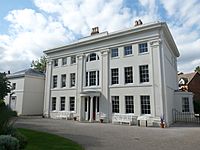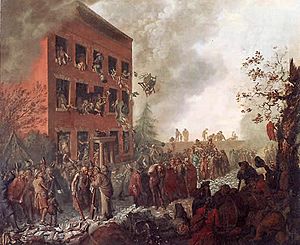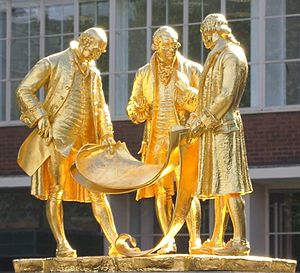Lunar Society of Birmingham facts for kids
The Lunar Society of Birmingham was a special club in Britain where important thinkers and inventors met. This group included people who owned factories, scientists, and other smart individuals. They gathered regularly in Birmingham between 1765 and 1813.
At first, they called themselves the Lunar Circle. By 1775, they officially became the "Lunar Society." They chose this name because they met during the full moon. The extra moonlight made it easier and safer for them to travel home, as there were no streetlights back then! The members even jokingly called themselves "lunaticks," which was an old way of saying "lunatics." They met in different places, like Erasmus Darwin's home in Lichfield, Matthew Boulton's home (Soho House), and other grand houses.

Soho House, a regular meeting place
|
|
| Formation | c. 1765 |
|---|---|
| Founder | Matthew Boulton, Erasmus Darwin, William Small |
| Type | Learned society, dinner club |
| Purpose | Scientific and intellectual discussion |
| Location | |
|
Key people
|
Matthew Boulton, Erasmus Darwin, Thomas Day, Richard Lovell Edgeworth, Samuel Galton, Jr., James Keir, Joseph Priestley, William Small, Jonathan Stokes, James Watt, Josiah Wedgwood, John Whitehurst, William Withering |
Contents
Who Were the Members?
The Lunar Society was never a formal club with strict rules. It was more like a group of friends who shared ideas. Because of this, there are no official lists of members or meeting notes. We only know about them from the letters and writings of the people involved.
Historians sometimes disagree on exactly who was a "member" and when the society truly existed. For example, some say Josiah Wedgwood was a main member, while others aren't so sure. The group started sometime between 1760 and 1775 and might have continued until 1813.
Despite these debates, we know that fourteen people regularly attended meetings during the society's most active years. These key members were:
- Matthew Boulton
- Erasmus Darwin
- Thomas Day
- Richard Lovell Edgeworth
- Samuel Galton, Jr.
- Robert Augustus Johnson
- James Keir
- Joseph Priestley
- William Small
- Jonathan Stokes
- James Watt
- Josiah Wedgwood
- John Whitehurst
- William Withering
Even though meetings were important, a lot of the society's work happened outside of them. Members who lived close to Birmingham talked almost every day. Those who lived farther away wrote letters at least once a week. Many other important people also visited meetings or worked with the members. These included famous figures like Benjamin Franklin and Joseph Banks.
Many historians believe the Lunar Society was very important. It helped spread new ideas in science and business across Britain and even beyond. People from all over Europe and America came to meet members like Boulton, Watt, and Small.
How the Society Grew
Early Friendships (1755–1765)
The Lunar Society began with a few friendships in the late 1750s. Matthew Boulton, who made metal goods, met Erasmus Darwin, a doctor and poet. They both loved experiments and inventions. Darwin had a strong understanding of science, and Boulton was great at putting ideas into practice. They visited each other often and studied things like electricity and weather.
Around the same time, John Whitehurst, a clockmaker from Derby, became friends with Boulton and Darwin. He supplied parts for Boulton's fancy metal items. Whitehurst was excited about his own inventions, like a device to measure heat.
These three friends were introduced to Benjamin Franklin in 1758. Franklin, a famous American inventor and statesman, visited Birmingham to meet important people. He returned in 1760 to do experiments with Boulton. Franklin remained a key connection for many early members.
The Lunar Circle (1765–1775)
The group changed a lot when William Small, a Scottish doctor, moved to Birmingham in 1765. He had been a professor in America and taught Thomas Jefferson. Small arrived with a letter of introduction to Matthew Boulton from Benjamin Franklin. His arrival made the existing group more organized, and they started inviting new members.
One of the first new members was Josiah Wedgwood, a famous pottery maker. He became good friends with Darwin. Wedgwood later designed his large pottery factory to be similar to Boulton's factory. Another new member, Richard Lovell Edgeworth, joined in 1766 because he was interested in carriage design. He then introduced his friend Thomas Day. In 1767, James Keir visited Darwin and decided to move to Birmingham to join the group.
The Lunar Circle also connected with people who lived farther away. Joseph Priestley, a scientist living in Leeds, joined the group in 1767. James Watt, who invented the improved steam engine, also visited Birmingham in 1767. Even though Priestley and Watt didn't move to Birmingham right away, they stayed in close contact with the members.
By 1768, a core group of nine people had formed, with William Small at the center. This group was sometimes called the "Lunar circle" by historians. The members themselves used names like "Birmingham Philosophers."
The Lunar Society Takes Shape (1775–1780)
When William Small died in 1775, the group became more organized. They decided to hold meetings on the Sunday closest to the full moon, from afternoon until evening. The first official meeting was likely on December 31, 1775. The name "Lunar" was first used in 1776.
New members joined during this time. William Withering, another doctor, moved to Birmingham in 1776 and became a member. John Whitehurst moved to London in 1775 but stayed in touch and sometimes attended meetings.
Matthew Boulton was a main leader in making the society more organized. His home, Soho House, was the main meeting place. In 1776, he planned to create "new Laws, and regulations" to help the society last. However, Boulton was very busy with his steam engine business, so he was often away. Even though the 1770s were a time of great achievements for the society, meetings became less frequent by the end of the decade.
The Society's Golden Age (1780–1789)
In late 1780, the society changed again when Joseph Priestley moved to Birmingham. Priestley had been involved with the group for over ten years and believed in the importance of scientific clubs. After he arrived, Lunar meetings moved from Sundays to Mondays to fit Priestley's schedule as a clergyman. Meetings also started happening at other members' homes, not just Soho House. This period became the society's most productive time.
Several important new people joined. Samuel Galton, Jr., a Quaker who made guns, started attending meetings in 1781. His daughter, Mary Anne Schimmelpenninck, later wrote one of the few firsthand accounts of the society's activities. Jonathan Stokes, a botanist and doctor, moved nearby and began attending meetings in 1783.
However, the society also lost some key members. Richard Lovell Edgeworth returned to Ireland in 1782. John Whitehurst died in 1788, and Thomas Day died the next year. Most notably, Erasmus Darwin moved to Derby in 1781. Even though he felt "cut off from the milk of science," he continued to attend meetings until at least 1788.
Decline (1789–1813)
The French Revolution in 1789 caused some disagreements among members. But it was the Priestley riots in Birmingham in 1791 that really hurt the society. Joseph Priestley was forced to leave town and moved to the United States in 1794. William Withering's house was attacked by rioters, and Matthew Boulton and James Watt had to arm their workers to protect their factory.
Younger generations of the families of original members tried to keep the meetings going. These included Gregory Watt, Matthew Robinson Boulton, Thomas Wedgwood, and James Watt junior. Meetings continued into the 1800s, but the strong teamwork that made the society famous was mostly gone.
The society officially ended by 1813. In August of that year, Samuel Galton, Jr. won a vote to take possession of the scientific books from the society's library.
Modern Lunar Societies
Today, there are many memorials to the original Lunar Society and its members. These include the Lunar Society Moonstones, statues of Watt, and the Boulton, Watt and Murdoch statue by William Bloye. The Soho House museum in Birmingham also celebrates their history.
A new Lunar Society was formed in Birmingham by Dame Rachel Waterhouse. This group aims to help develop the city and the surrounding area. As of 2024, this society is still active.
University of Birmingham Lunar Society
At the University of Birmingham, a student group called the Lunar Society meets to discuss many different topics. It was reformed in 2012 and now holds discussions every two weeks. Any member can suggest a topic. The society believes strongly in freedom of speech. In 2019, this society changed its name to the Devil's Advocate Society, but it kept the same goals as the original Lunar Society.
Today, this group is an informal academic club open to all students and professors at the University of Birmingham.
Archives
Historical materials about the Lunar Society are kept in several places. The Cadbury Research Library at the University of Birmingham has portraits of the original members. The Library of Birmingham has a large collection of Joseph Priestley's writings. Both archives also hold many letters from the society's members.
See also
 In Spanish: Sociedad Lunar para niños
In Spanish: Sociedad Lunar para niños










